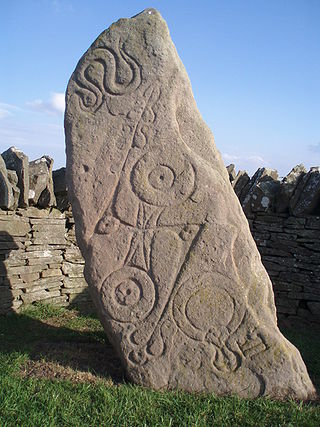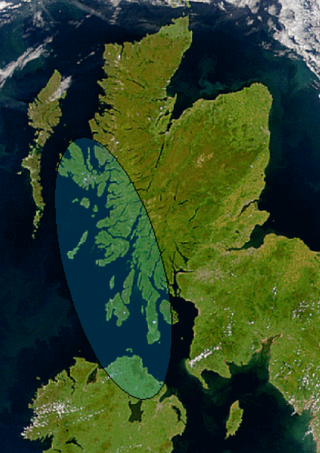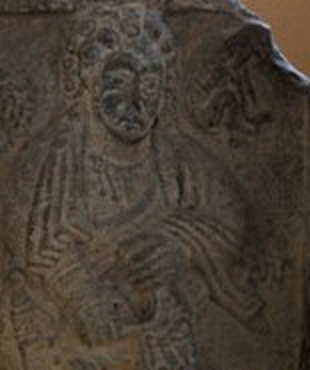Related Research Articles

Causantín mac Áeda was an early King of Scotland, known then by the Gaelic name Alba. The Kingdom of Alba, a name which first appears in Constantine's lifetime, was situated in modern-day Northern Scotland.

The Picts were a group of peoples in northern Britain, north of the Firth of Forth, in the Early Middle Ages. Where they lived and details of their culture can be gleaned from early medieval texts and Pictish stones. The name Picti appears in written records as an exonym from the late third century AD. They are assumed to have been descendants of the Caledonii and other northern Iron Age tribes. Their territory is referred to as "Pictland" by modern historians. Initially made up of several chiefdoms, it came to be dominated by the Pictish kingdom of Fortriu from the seventh century. During this Verturian hegemony, Picti was adopted as an endonym. This lasted around 160 years until the Pictish kingdom merged with that of Dál Riata to form the Kingdom of Alba, ruled by the House of Alpin. The concept of "Pictish kingship" continued for a few decades until it was abandoned during the reign of Caustantín mac Áeda.

Dál Riata or Dál Riada was a Gaelic kingdom that encompassed the western seaboard of Scotland and north-eastern Ireland, on each side of the North Channel. At its height in the 6th and 7th centuries, it covered what is now Argyll in Scotland and part of County Antrim in Northern Ireland. After a period of expansion, Dál Riata eventually became associated with the Gaelic Kingdom of Alba.

Domnall mac Causantín, anglicised as Donald II, was King of the Picts or King of Alba in the late 9th century. He was the son of Constantine I. Donald is given the epithet Dásachtach, "the Madman", by the Prophecy of Berchán.
Óengus mac Fergusa was king of the Picts from 820 until 834. In Scottish historiography, he is associated with the veneration of Saint Andrew, the patron saint of Scotland, although this has not been proven.
Dúnchad mac Conaing was king of Dál Riata. He was joint ruler with Conall Crandomna until he was defeated and killed by Talorgan son of Eanfrith, king of the Picts, in the Battle of Strathyre. Sources differ on Dúnchad's patronym and thus his presumed ancestry.

Áedán mac Gabráin, also written as Aedan, was a king of Dál Riata from c. 574 until c. 609 AD. The kingdom of Dál Riata was situated in modern Argyll and Bute, Scotland, and parts of County Antrim, Ireland. Genealogies record that Áedán was a son of Gabrán mac Domangairt.
Talorgan son of Eanfrith was a King of the Picts from 653 to 657. As with his successors Gartnait son of Donuel and Drest son of Donuel, he reigned as a puppet king under the Northumbrian king Oswiu.

Óengus son of Fergus was king of the Picts from 732 until his death in 761. His reign can be reconstructed in some detail from a variety of sources. The unprecedented territorial gains he made from coast to coast, and the legacy he left, mean Óengus can be considered the first king of what would become Scotland.

Bridei son of Maelchon was King of the Picts from 554 to 584. Sources are vague or contradictory regarding him, but it is believed that his court was near Loch Ness and that he may have been a Christian. Several contemporaries also claimed the title "King of the Picts". He died in the mid-580s, possibly in battle, and was succeeded by Gartnait son of Domelch.

Bridei son of Beli ; died 692) was king of Fortriu and of the Picts from 671 until 692. His reign marks the start of the period known to historians as the Verturian hegemony, a turning point in the history of Scotland, when the uniting of Pictish provinces under the over-kingship of the kings of Fortriu saw the development of a strong Pictish state and identity encompassing most of the peoples north of the Forth.
Nechtan grandson of Uerb, was king of the Picts from 595 to around 616, and may be the same person as the Neithon son of Guipno who ruled the kingdom of Alt Clut.
Nechtan, son of Erip, was the king of the Picts from 456 to 480.
Neithon son of Guipno was a 7th-century ruler of Alt Clut, a Brittonic kingdom based on Dumbarton Rock. According to the Harleian genealogies, he was the son of Guipno map Dumnagual Hen. Alfred Smyth suggests he is the same man as King Nechtan the Great of the Picts, and perhaps the Nechtan son of Canu the Annals of Ulster record as having died in 621. The Senchus fer n-Alban indicate that Gartnait, the son of Áedán mac Gabráin, King of Dál Riata, sired a son named Cano, but unless the Harleian genealogies are to be ignored, this would make Gartnait and Dumnagual Hen the same persons, as the respective fathers of Gartnait and Guipno. However, it is possible that either as an Alt Clut Briton ascending the throne of Pictland, or as a Pict ascending the throne of Alt Clut, his genealogy might have been altered, and it is notable that in the Pictish king-lists he is called "Nechtan, nepos Uerb", suggesting that it was a descent from Uerb that mattered in Pictland, and not his unimportant father Guipno/Canu. Alan Orr Anderson pointed out that Uerb is probably the Pictish form of Ferb, a female name. Alan MacQuarrie suggests that Neithon was indeed the Pictish king Nechtan, but does not take any stance on the Guipno/Canu problem.
Elfin was a ruler of Alt Clut, a Brittonic kingdom based on Dumbarton Rock, sometime in the later 7th century. According to the Harleian genealogies, he was the son of Eugein I, one of his predecessors as king, and the father of Beli II, who ruled some time later. Very little is certainly known of him, though he may be identifiable with other figures attested in the Irish annals, and circumstantial evidence may link him to a number of important events during this time.
Gartnait son of Donuel was king of the Picts from 657 until 663.
Drest son of Donuel was king of the Picts from c. 663 until 672. Like his brother and predecessor Gartnait son of Donuel, and Gartnait's predecessor Talorgan son of Eanfrith, he reigned as a puppet king under the Northumbrian king Oswiu. Gartnait and Drest may have been sons of Domnall Brecc, who was king of Dál Riata from c.629 until he was killed in 642.
Talorg son of Uuid was a king of the Picts from 641 to 653.
Gwid son of Peithan was a warband leader allied with the northern Britons fighting against the Angles of Northumbria in the early 7th century, recorded in the Welsh poem Y Gododdin. He is described in Y Gododdin as a "steadfast warrior" and may have been either a southern Pict or a northern British chief.
References
- Anderson, Alan Orr (1990), Early Sources of Scottish History A.D 500–1286, vol. I (2nd ed.), Stamford: Paul Watkins, ISBN 1-871615-03-8
- Anderson, M. O. (1980), Kings and Kingship in Early Scotland (2nd ed.), Edinburgh: Scottish Academic Press, ISBN 0-7011-1604-8
- Bannerman, John (1974), Studies in the History of Dalriada, Edinburgh: Scottish Academic Press, ISBN 0-7011-2040-1
- Charles-Edwards, T. M. (2006). The Chronicle of Ireland. Translated Texts for Historians. Vol. 44. Liverpool: Liverpool University Press. ISBN 0-85323-959-2.
- Evans, Nicholas (2008), "Royal succession and kingship among the Picts", The Innes Review, 59 (1), Edinburgh: Edinburgh University Press: 1–48, doi:10.3366/e0020157x08000140, hdl: 20.500.11820/657d2747-c29d-4254-989d-eb23970a9684 , ISSN 0020-157X
- Fraser, James E. (2009). From Caledonia to Pictland: Scotland to 795. New Edinburgh History of Scotland. Vol. I. Edinburgh University Press. ISBN 978-0-7486-1232-1.
- Smyth, Alfred P. (1989). Warlords and Holy Men: Scotland AD 80-1000. Edinburgh University Press. ISBN 0-7486-0100-7.